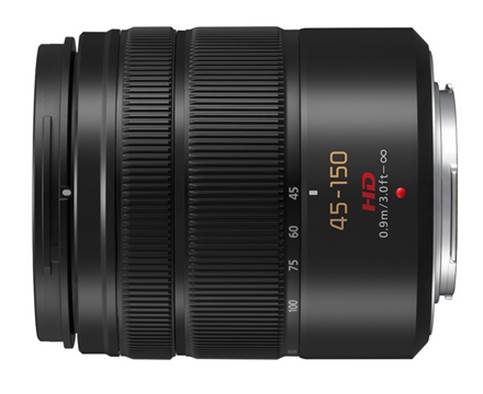High-performing and competitively
priced telephoto zoom
Panasonic’s G-series 45-150mm lens sits
alongside two alternatives; one covers 45-175mm (with a power zoom) and the
other covers 45-200mm. The 45-175mm PZ is significantly more expensive but
superficially there is little to choose between the other two.
Clearly the 45-200mm lens is more
attractive by virtue of having a wider zoom range but the 45-150mm lens is not
only around $80 cheaper but also smaller and lighter. In addition, it has been
designed for both still-picture and video photography, which means it is
effectively silent in use. In short, what it lacks in zoom range it makes up
for elsewhere.

Panasonic
G Vario 45-150mm f/4-5.6 Aspherical Mega OIS
Externally this is a very traditional lens,
without the rocker switches that adorn Panasonic’s power-driven zooms. A broad
zoom ring fills the center third of the barrel with a smaller focusing ring in
front there is nothing to the rear as mode changes for focusing and image
stabilization are carried out on the camera body.
Both rings sit readily within reach and
have a smooth feel with just the right amount of resistance. The zoom ring
rotates through very nearly ninety degrees and extends by about 50%.

Externally
this is a very traditional lens, without the rocker switches that adorn
Panasonic’s power-driven zooms.
It is worth noting that the lens has to be
refocused after zooming and the minimum object distance (closest focusing
distance) increases with longer focal lengths. Also, the lens is less likely to
focus automatically in dimly-lit environments when a longer focal-length
setting is used.
Despite its highly unassuming nature this
proved to be a very enjoyable lens to use. It feels well matched on a
Micro-Four-Thirds body, without the excess mass and bulk that some telephoto
lenses bring to small-format cameras. Focusing was indeed virtually silent and
also refreshingly quick. The zoom’s large-scale use of plastics to keep the
weight down might be a cause for concern but the lens mount itself is made of
metal and is securely seated into the barrel.
Technical testing revealed a near-total
absence of chromatic aberration. Encouraging though any freedom from color
fringing must be, there was something a little odd about the tonal curves
across high-contrast boundaries that may have been due to the application of an
image correction technique to remove color fringes rather than a genuine
freedom from them. Although that explanation is pure conjecture it is true to
say that in real-world images there were signs of a lack of tonal smoothness,
so perhaps there is a tonality issue after all - but if so then that is a
camera quirk, not a lens characteristic.
At under $480 this lens is something of a
bargain. It has a virtually silent AF system and is both lightweight and
compact.
Overall this is the perfect multipurpose
telephoto zoom for old-fashioned photographers who prefer to control their
lenses via rotating rings rather than power-driven mechanisms.

At
under $480 this lens is something of a bargain. It has a virtually silent AF
system and is both lightweight and compact.
|
Specifications
§
Price : $448
§
Max aperture: f4.0 - 5.6
§
Min aperture: f/22
§
Lens mount: Micro Four-Thirds
§
Number of Blades: 7
§
Image Stabilization: Yes
§
Optics (elements/groups): 12/9
§
Min focus: 0.9m
§
Filter size: 52mm
§
Lens hood: Yes
§
Width: 62mm
§
Length: 73mm
§
Weight: 200g
PROS
§ No
visible color fringing
§ Well-balanced
on camera body
§ Near-silent
focusing
§ Compact
design
CONS
§
Power zoom and focusing requires
familiarization
§
Lens less Likely to focus in dimly Lit
environments
|